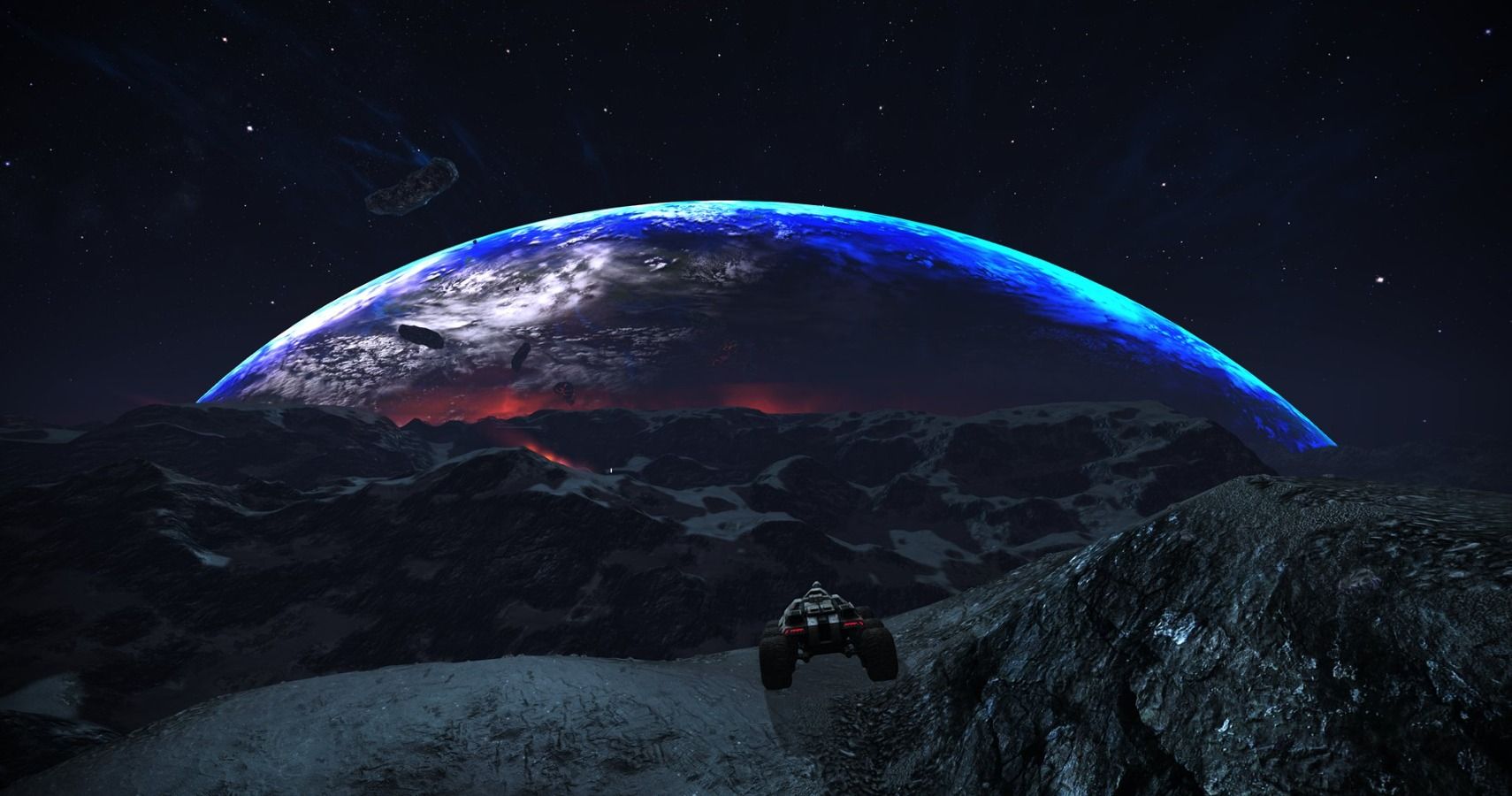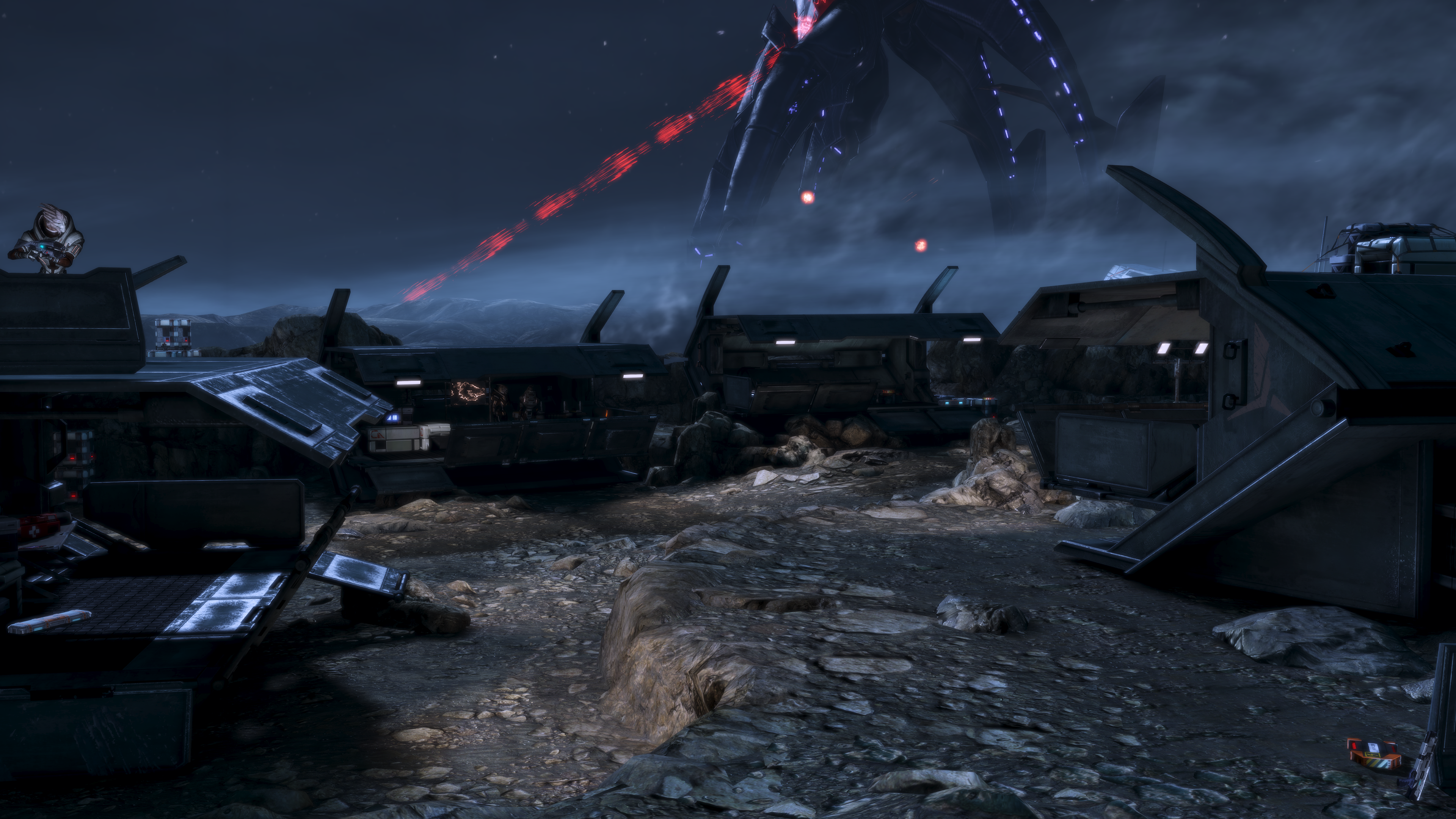From snowscapes and shattered relics of an ancient civilization to plague-infested highrises and the Mass Effect equivalent of a gamified James Bond movie, the artistic shift from Mass Effect to Mass Effect 2 is stark, striking, and spectacular. The first game brilliantly articulates the enormous, unquantifiable scale of the universe by going hard on environmental scope – even if you don’t like the Mako, you can’t deny how gorgeous those views are. The second one, despite having too many shooting galleries, excels in much narrower, more truncated set design. It’s an exercise in futuristic urbanism that blends progress with ruin.
Mass Effect 3, despite being the most visually appealing game in the trilogy – at least in terms of bright colours and realistic faces, which aren’t half as important as certain people might lead you to believe – isn’t capable of evoking either atmosphere. It’s not that the environmental design is bad. I played through Garrus’ recruitment mission on Palaven’s moon yesterday and the backdrops are enormous. It creates a bombastic picture of annihilation, with clever uses of perspective perfectly articulating the sheer size of the Reapers in comparison to the ravaged turian homeworld behind them. It’s all a bit shallow, though, with depth of field doing the kind of heavy lifting that was previously assigned to tight design. You could see Earth from the moon in the first Mass Effect, but the distance and progressive design between them was much more precise. I understand the galaxy is at war, but the blurriness and broodiness of its aesthetic are at fundamental odds with one another.
This issue is compounded by the adoption of more Mass Effect 2 shooting galleries, although this time around they’re grey instead of beige. Level design is all collapsed pillars and chest-high chunks of stone and metal, although it never quite reaches the kind of organic industrial integration of Zaeed’s loyalty mission in Mass Effect 2. Combat is miles better in Mass Effect 3, mind, with crunchier gunfeel and palpable powers – it’s just that the arenas it takes place in are less inspired. Maybe that’s the point – they’re grim and boring because the world is on fire. I can understand grimness for sure, although I never imagined the apocalypse incarnate would be boring. It feels smaller than the first game and less contained than the second, despite the fact it transpires across the entire Milky Way and is supposedly laser-focused on the immediacy of the Reaper threat. That’s the main thing here – without Mass Effect’s naturalness or Mass Effect 2’s urbanism, or an equally viable environmental theme, Mass Effect 3 doesn’t feel cohesive enough for the Reapers to be as intimidating as they should be. I’ll happily tick off missions in 50 shades of grey combat arenas at my own pace.
Don’t get me wrong, it’s not all bad. In cutscenes, the environments are much stronger. The escape sequence on Thessia properly captures the ruin and ravaging wrought by the Reapers, with the once-gorgeous asari homeworld going up in sinister smoke. When you’re playing through the mission, though, this kind of evocative atmosphere is lost. Mass Effect 3’s environments are at their worst when they’re playable – when they’re pre-rendered for explicitly narrative sequences with no covering or shooting, they’re phenomenal. It’s just that Mass Effect 3 is, you know, a cover shooter, so you’d think its aesthetic integrity would be maintained for the occasions in which it’s fulfilling that genre role.
My main issue with Mass Effect 3’s aesthetic is that other games have accomplished the exact same thing to far greater effect. When you play Nier: Automata, the scope of the apocalypse is a phenomenon in and of itself. Horizon Zero Dawn’s decay is its own character, with large and looming metal megastructures communicating the mysteries that come with decadence and dilapidation. Sure, Mass Effect 3 isn’t post-apocalyptic, but a lot of its design is similar – and inferior. There’s very little scalability, the worlds emphatically feel like small outcroppings designed for a mission to take place on – which they are, but they shouldn’t feel like that – and as a result, it often rings hollow. Combining the first game’s aesthetic investment in nature with the thematic urbanism of Mass Effect 2 could have led to an organic backbone for Mass Effect 3. Instead, it’s all concrete jungles where everything you’re allowed to do is visible at first glance – chest-high walls over there for a shooting gallery, an alcove on the left for a medkit, and a token moon in the background to remind you there are giant ancient machine aliens shooting laser beams all over the gaff.
There’s just too much going on to properly instill the core message of ruin and destruction at the core of the game. The end of the world is messy and unpredictable, but Mass Effect 3’s levels and environments are messy and… predictable. Nature and metropolis alike are dilapidated before the process of dilapidation, which makes sense in a narrative context, but falls flat because the visual representation of this is lackluster. It’s a game with more polygons than either of its predecessors, but it has less soul despite inherently being the most necessarily soulful.
Art direction is incredibly important in video games, especially in science fiction that is attempting to create a striking vision of the distant future. From Noveria to Ilos, the first Mass Effect has the best art direction in the series – and it’s not even close. The second game is at least functionally respectable and offers us a look into the smaller elements of the universe, from Omega’s criminal underworld to Wrex’s throne of stone in the middle of Tuchanka’s rubble. Put plainly, Mass Effect 3 just lacks character in comparison, despite all of the bright lights and pretty colours – although I’ll admit watching a thresher maw eat a Reaper is pretty damn brilliant.
All in all, Mass Effect 3 is loud and bombastic, and it’s excellent in a wide variety of different ways. Ultimately, though, it’s the series’ weakest entry in terms of art, despite the fact its premise has the most potential – still better than Mass Effect 2’s Citadel, though.
Source: Read Full Article

